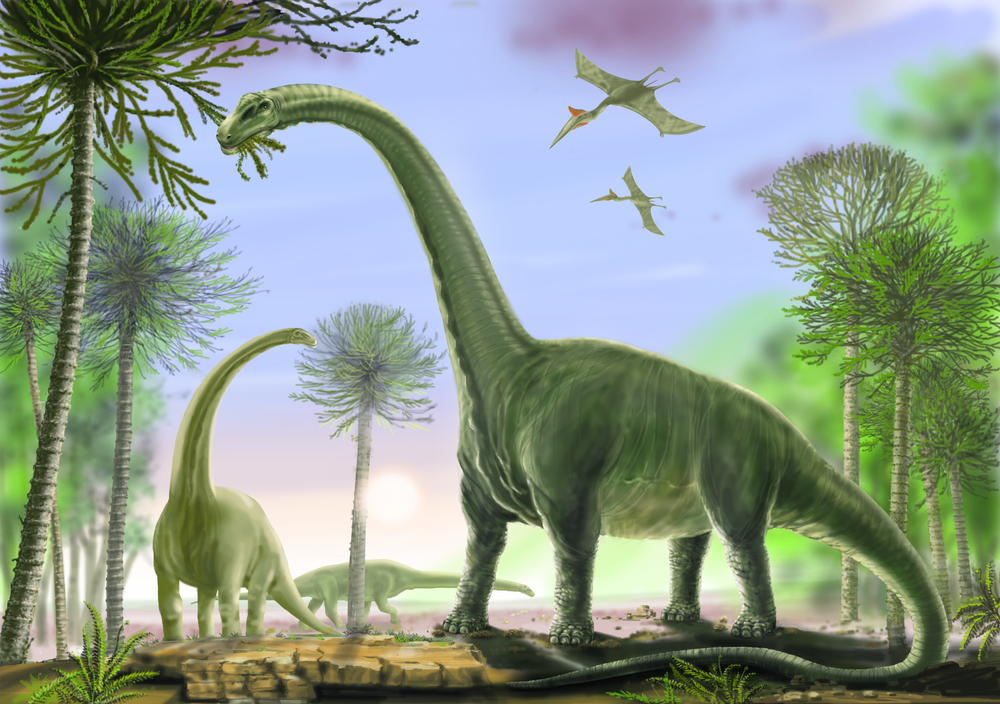How the Titanosaur Lived: The Biggest Dinosaur to Ever Walk on Earth
Posted on Categories Discover Magazine

Titanosaurs, a diverse group of long-necked sauropod dinosaurs, were found on every continent, including Antarctica, in their Cretaceous heyday.
They lived right up until the end of all other non-bird dinosaurs, when the Chicxulub asteroid struck the Yucatan Peninsula about 66 million years ago.
Paleontologists have discovered dozens of distinct titanosaurs, many of them relatively recently in fossil beds in South America. Nearly all of the group are massive, but like other sauropods, these giants mostly fed on vegetation.
“They could even eat very small plants,” says Julian Silva Jr., a paleontologist with the University of Sao Paolo’s Ribeirao Preto campus.
The Discovery of the Biggest Dinosaur to Walk on Land
(Credit: Chansak Joe/Shutterstock)
The largest animals to ever walk the Earth would have dwarfed a modern-day elephant. Interestingly, the discovery of titanosaurs got off to something of a false start. The first fossils given this name were found in Cretaceous-era rocks in India.
The remains were initially dubbed Titanosaurus indicus and Titanosaurus blanfordi, though these were later found to be invalid taxa as there weren’t enough distinguishable remains to reliably say they were species, Silva Jr. says.
Since then, titanosaur fossils have been found on every continent, though they were most abundant in South America and Africa. In fact, in South America they may have been the most abundant herbivores during the Cretaceous.
Read More: The End of the Dinosaurs: What Was the End-Cretaceous Mass Extinction?
What Was the Largest Titanosaur?
The largest titanosaur yet found may be Patagotitan mayorum, a species named after the Patagonia area of Argentina where the first remains were discovered. Researchers have fairly complete fossil remains of Patagotitan — a cast of one can be seen on display at the Field Museum in Chicago.
But the Argentinosaurus isn’t far behind, and might be even larger than Patagotitan; paleontologists aren’t certain because they haven’t discovered as many Argentinosaurus fossils. Both of the latter are estimated at about 30 meters long from head to tail.
The Puertasaurus, also found in Argentina, was close to these lengths as was the Dreadnoughtus. Meanwhile, the Alamosaurus — a titanosaur found in the southwestern U.S. —may have measured nearly as large as some of these South American giants.
One theory about why they reached such massive sizes has to do with their unique breathing system. All sauropods have an efficient, bird-like breathing system that involved air sacks in their bones. The breathing system of titanosaurs, specifically, was even more developed along these lines, which may have helped them get larger than most sauropods.
Read More: How Sauropods Evolved to Their Enormous Size
What Did Titanosaurs Eat?
Strangely enough, paleontologists have found nearly no teeth from these species. But Silva Jr. and his colleagues recently described teeth found in the state of Minas Gerais in Brazil. Silva Jr. is uncertain which species they belong to, but they may be from Uberabatitan, a large species of titanosaur found in the area.
“This is the largest titanosaur tooth. Also, likely the sauropods’ largest one, though we have not comprehensively compared it to every lineage within this group,” he says.
Titanosaurs subsisted mostly on plants and vegetation, using their long necks to eat everything from shorter plants on the ground to leaves on top of trees. But Silva Jr. says that, despite their massive size, they likely subsisted on a relatively lean diet.
“We think they had very well-adapted organs,” Silva Jr. says, adding that this may have helped titanosaurs metabolize calories efficiently. Otherwise, “it’s hard to imagine a forest that could deal with a herd.”
Read More: Why Are Herbivore Dinosaurs Important, and What Can They Teach Us About Evolution?
How Did Titanosaurs Live?
Paleontologist believe they lived in herds due to fossil-rich deposits in places like Texas and Uberaba in South America. These fossil records show dozens of different-aged titanosaurs from the same species together, including adults and juveniles.
Titanosaurs also laid a lot of eggs — perhaps using a strategy similar to sea turtles today, in which only a few survive to adulthood. Just the same, once they were a certain size, not much would have preyed on them, similar to elephants today.
“Right now, we don’t think that any predator could kill a fully healthy [adult] titanosaur,” Silva Jr. says.
That isn’t to say that some creatures didn’t feed on them—one recent study discovered titanosaurs suffered from a parasite that might have eaten parts of their skin away.
Titanosaurs such as Uberabatitan didn’t necessarily migrate long distances, or they at least returned to the same places throughout their lives. Eggs from that species have been found in the same area as juveniles and adults.
“Their whole life circle was in the same place,” Silva Jr. adds.
Read More: How Did Dinos Lay Eggs and What Were Dinosaur Eggs Like?